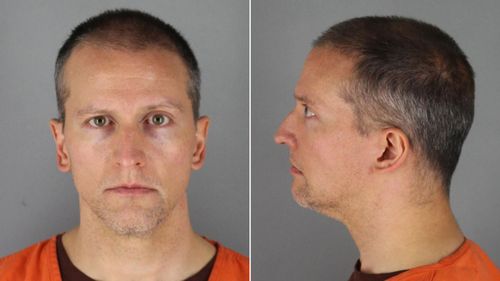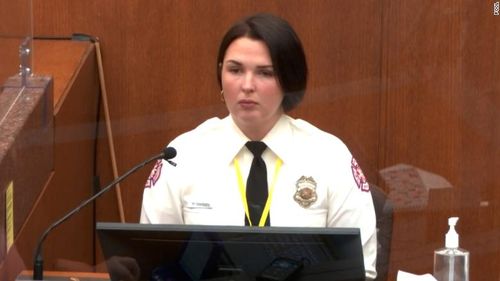Sgt. Jon Edwards, a 14-year police veteran, said he arrived to secure the scene of a “possible critical incident” shortly after 9:30pm. He had other officers canvass the area for potential witnesses.
At the scene, Edwards said, he asked two officers — J. Alexander Kueng and Thomas Lane — to activate their body-worn cameras. Both officers were later charged with aiding and abetting second-degree murder and aiding and abetting second-degree manslaughter.

Lt. Richard Zimmerman, head of the homicide division for more than 12 years, arrived at the Chicago Avenue scene shortly before 10pm Kueng and Lane were taken to City Hall as part of a critical incident investigation, according to Edwards.
Zimmerman took the witness stand after Edwards.
The jury returned Friday for the abbreviated fifth day of testimony after, a day earlier, hearing Chauvin’s perspective in the minutes after Floyd’s limp body was taken away in an ambulance. It was the second time they heard his take on the events of that day. Judge Peter Cahill said he would send jurors home early on Friday because the trial was ahead of schedule.
A call to Sgt. David Pleoger, his supervisor at the time, was captured on body camera footage and played during Pleoger’s testimony on Thursday. Chauvin made the call shortly after kneeling on Floyd’s neck for more than nine minutes on May 25 to explain his version of what happened.

“I was just going to call and have you come out to our scene here,” Chauvin told Pleoger. “We just had to hold a guy down. He was going crazy. He wouldn’t … he wouldn’t go in the back of the squad — “
The video ends but in the rest of the call, Chauvin said Floyd had a medical emergency after struggling with officers trying to put him into a car, according to Pleoger. Chauvin did not mention holding his knee down on Floyd’s neck and back, Pleoger said.
Pleoger drove to the scene and asked officers to speak to witnesses. “We can try, but they’re all pretty hostile,” Chauvin responded.
Later that night, at the Hennepin County Medical Centre, Chauvin told his supervisor that he had knelt on Floyd’s neck, Pleoger told the jury.
The clip from Chauvin’s body camera played for the jury on Wednesday also showed him defending his actions to a bystander who called him out for his treatment of Floyd.

“That’s one person’s opinion,” Chauvin responded as he got into his squad car. “We had to control this guy because he’s a sizeable guy. It looks like he’s probably on something.”
Supervisor says Chauvin’s use of force should have ended earlier
Pleoger’s testimony centred on police protocols for the use of force. Officers can use force in certain circumstances, but that force should stop once the person is under control.
Pleoger testified that his review of bodycam footage showed Chauvin’s use of force should have ended earlier.
“When Mr. Floyd was no longer offering up any resistance to the officers, they could have ended the restraint,” he said. “It would be reasonable to put a knee on someone’s neck until they were not resisting anymore, but it should stop when they are no longer combative.”

He said officers are required to call an ambulance and provide emergency aid while waiting for the ambulance. Restrained persons should be put on their side to help their breathing.
Pleoger, on cross examination, said he had not conducted a formal use of force review because the death investigation moved up the chain of command.
A pair of Hennepin County paramedics said Floyd he was unresponsive, not breathing and had no pulse when they arrived on the scene.
“In layman terms, I thought he was dead,” paramedic Derek Smith said.
Smith and his partner Seth Bravinder were first called to the scene as a non-emergency Code 2 for a mouth injury. A minute and half later, the call was upgraded to a Code 3 — meaning the ambulance uses lights and sirens.
Floyd did not appear to be breathing or moving. Smith checked Floyd’s pulse and pupils while Chauvin kept his knee on him. The paramedic said he believed his heart had stopped. Bravinder motioned for Chauvin to lift his knee off Floyd to get him on a stretcher and in the ambulance.

Bravinder said they were concerned about the crowd of bystanders.
An officer climbed into the ambulance and helped with chest compressions. Smith removed Floyd’s handcuffs, he testified. Bravinder stopped the ambulance at one point to assist in Floyd’s treatment, he testified.
In the ambulance, however, Floyd had flatlined — meaning his heart showed no activity. Attempts to restart his heart with chest compressions, establishing an airway and electric shock failed. They dropped him off at the hospital
Fire Department Capt. Jeremy Norton testified that no one ever found a pulse in Floyd’s body. He later reported the incident to superiors in the Fire Department because it involved the death of someone in police custody and an off-duty firefighter was a witness.
Floyd and girlfriend struggled with opioid addiction
Courteney Ross, 45, told the jury she met Floyd in August 2017. He worked as a security guard at the Salvation Army.
Floyd worked out every day and never complained of shortness of breath, she said. He was a mama’s boy who was a “shell of himself” after his mother’s death in 2018.

They both struggled with addiction to opioids, she testified. They were prescribed opioid painkillers to treat chronic pain, which ultimately led to an addiction and their use of street drugs, she testified.
In March 2020, she found Floyd doubled over in pain and took him to the emergency room, she testified. He had overdosed, she said. She said she believed he had started using again in May 2020.
In opening statements, prosecutors acknowledged Floyd’s history of opioid addiction but said it was irrelevant to his death last May. But defence attorney Eric Nelson argued that Floyd’s true cause of death was drug use and several preexisting health issues.
This content first appear on 9news

Muchas gracias. ?Como puedo iniciar sesion?